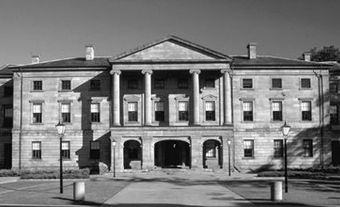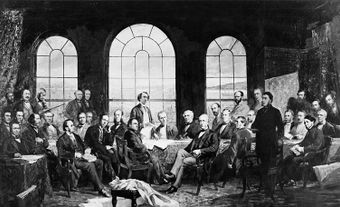The Statute of Westminster, 1931 is a British law. It was passed on 11 December 1931. It made all the Commonwealth countries independent and equal with Britain. They now had full legal freedom except in areas of their choosing. The Statute also clarified the powers of Canada’s Parliament and those of the other Dominions.
(This article is a plain-language summary of the Statute of Westminster, 1931. If you are interested in reading about this topic in more depth, please see our full-length entry, Statute of Westminster, 1931.)

Desire for Autonomy
Before 1931, Britain had some powers over laws passed by the Commonwealth countries. The British Parliament could also override the governments in those countries.
This began to change after the First World War. Canada and other Dominions had given much to the war effort. This had stirred feelings of nationhood. These countries now wanted more control of their affairs.
In the early 1920s, Canada took steps to be more independent in foreign policy. The Chanak Affair of 1922 was one example of this. The Halibut Treaty of 1923 was another. In 1926, Canada opened an embassy in Washington, DC. Vincent Massey was named its first ambassador. This made him Canada’s first diplomat in a foreign capital.
Balfour Report and Imperial Conferences
The Balfour Report of 1926 said that Britain and its Dominions were “equal in status.” Imperial Conferences were then held later that year. More were held in 1929 and 1930. The goal was to update the Commonwealth’s legal system.

Gradual Change
The Statute of Westminster, 1931 was passed by the British Parliament on 11 December 1931. This was done at the request of the Dominions. It was also done with their consent. This was a vital step in making the Dominions independent.
Yet some limits remained. Canada’s federal and provincial leaders could not agree on how to change the BNA Act. (It is now called the Constitution Act, 1867). As a result, Canada asked Britain to keep the power to change Canada’s Constitution until Canadians could come up with their own way of doing so. This power remained with Britain until the Constitution Act, 1982 was passed. It added an amending formula (a method for making changes). (See Patriation of the Constitution.)
Other parts of the Statute allowed the Dominions to pass laws that went against colonial policy. This meant Canada could apply its laws outside the country. For example, with its vessels at sea, or with Canadian Armed Forces serving abroad.
Canada took some time to adopt all its new powers under the Statute of Westminster. For example, the Judicial Committee of the Privy Council in Britain remained Canada’s final court of appeal until 1949. That power was then shifted to the Supreme Court of Canada.
See also Constitution of Canada (Plain-Language Summary); Constitution Act, 1867 (Plain-Language Summary); Constitution Act, 1982 (Plain-Language Summary); Canadian Charter of Rights and Freedoms (Plain-Language Summary); Patriation of the Constitution (Plain-Language Summary).

 Share on Facebook
Share on Facebook Share on X
Share on X Share by Email
Share by Email Share on Google Classroom
Share on Google Classroom






